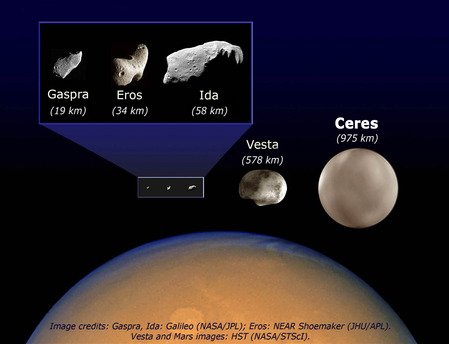Shapes of celestial bodies
Why aren't all celestial bodies spherical?
 |
The illustration compares the size of five asteroids – Gaspra, Eros, Ida, Vesta and Ceres – and the planet Mars (circular section in the lower part of the picture). The figure in brackets indicates the size of each body at its largest point.
The form of a body is determined by the interaction between its gravity and solidity. Small asteroids and comets have little gravity, which is insufficient to force their larger rocks into a spherical distribution. But the gravity of the significantly larger moons and planets is so strong, by contrast, that it turns these celestial bodies into spheres. There are, of course, still uneven features on the surface of planets, such as mountains and valleys, but they become smaller as gravity increases.
(See ‛What is the highest mountain in our solar system?’) Irrespective of the material composition of the celestial body, a diameter of a few hundred miles is sufficient to create a spherical form – the largest asteroids, Ceres and Vesta, already have a pronounced round shape.
The shape of celestial bodies – not perfect
Rotation – that is, the spin around their own axis – also plays an important role with regard to the shape of celestial bodies. The asteroid Cleopatra, for example, describes a full rotation in as little as 5.3 hours and therefore has the elongated form of a dumbbell: it is 135 miles long with a diameter of only about 56 miles. The large planets, too, are deformed through their rotation. The faster a planet rotates, the wider it becomes at the equator and the flatter at the poles. Our Earth is not a perfect sphere either. Its diameter over the poles is 26.5 miles smaller than at the equator.
German Aerospace Center
Shapes of celestial bodies
Why aren't all celestial bodies spherical?
 |
The illustration compares the size of five asteroids – Gaspra, Eros, Ida, Vesta and Ceres – and the planet Mars (circular section in the lower part of the picture). The figure in brackets indicates the size of each body at its largest point.
The form of a body is determined by the interaction between its gravity and solidity. Small asteroids and comets have little gravity, which is insufficient to force their larger rocks into a spherical distribution. But the gravity of the significantly larger moons and planets is so strong, by contrast, that it turns these celestial bodies into spheres. There are, of course, still uneven features on the surface of planets, such as mountains and valleys, but they become smaller as gravity increases.
(See ‛What is the highest mountain in our solar system?’) Irrespective of the material composition of the celestial body, a diameter of a few hundred miles is sufficient to create a spherical form – the largest asteroids, Ceres and Vesta, already have a pronounced round shape.
The shape of celestial bodies – not perfect
Rotation – that is, the spin around their own axis – also plays an important role with regard to the shape of celestial bodies. The asteroid Cleopatra, for example, describes a full rotation in as little as 5.3 hours and therefore has the elongated form of a dumbbell: it is 135 miles long with a diameter of only about 56 miles. The large planets, too, are deformed through their rotation. The faster a planet rotates, the wider it becomes at the equator and the flatter at the poles. Our Earth is not a perfect sphere either. Its diameter over the poles is 26.5 miles smaller than at the equator.
German Aerospace Center





